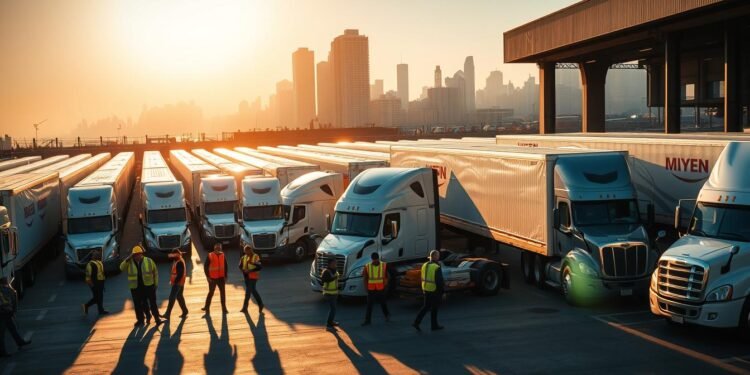Did you know the trucking industry moves 71% of all US freight, generating over $800 billion annually? With such high demand, launching a freight business presents a lucrative opportunity. But where do you begin?
The industry supports 6% of all US jobs, offering stability even in uncertain economic times. Companies rely on trucks to keep goods moving—America’s supply chain depends on it.
Entrepreneurs can choose between operating as an owner-operator or building a fleet. Each path has unique challenges and rewards. Understanding the market is key to long-term success.
Key Takeaways
- Trucking moves 71% of US freight, creating massive opportunities
- The industry employs 6% of American workers
- Owner-operators and fleet owners face different challenges
- Supply chains depend heavily on reliable trucking services
- Proper planning separates successful ventures from failures
1. Understand the Trucking Industry Landscape
Without trucks, store shelves would empty within days—proof of this industry’s critical role. The trucking industry contributes $791 billion annually to the US GDP, ensuring everything from pharmaceuticals to produce reaches consumers. During emergencies like hurricanes, trucks deliver lifesaving supplies, showcasing their irreplaceable position in the business ecosystem.
Economic Impact and Supply Chain Dependence
Seventy-one percent of US freight travels by truck, totaling 10 billion tons yearly. Retailers operate on a “72-hour supply chain,” meaning disruptions halt deliveries within three days. This vulnerability underscores why logistics companies prioritize reliable haulers.
Owner-Operator vs. Fleet Ownership
An owner-operator might invest $15,000–$30,000 for a single truck, while building a fleet requires $500,000+. Independent drivers control their schedules but handle maintenance, whereas fleet businesses manage drivers and scale operations. Both models thrive in today’s market but cater to different goals.
Specialized niches like refrigerated (“reefer”) or flatbed hauling offer higher profits but demand specific equipment. Meanwhile, e-commerce growth fuels demand for less-than-truckload (LTL) services, creating opportunities for agile companies.
2. Obtain a Commercial Driver’s License (CDL)
Operating commercial trucks legally requires a specialized credential that ensures safety and compliance. The commercial driver license (CDL) is mandatory for vehicles weighing over 26,001 pounds or transporting hazardous materials. Investing in proper certification opens doors to lucrative freight opportunities.
CDL Classifications and State-Specific Rules
States issue three license classes: Class A (tractor-trailers), Class B (straight trucks), and Class C (passenger or hazmat vehicles). Endorsements like tanker or double/triple trailers expand job prospects. For example, Texas requires additional testing for school bus operations, while California enforces stricter emissions training.
Training Programs and Certification Process
Community colleges offer affordable CDL programs ($3,000–$5,000), while private schools provide faster tracks ($5,000–$7,000). All courses cover 160+ hours of hands-on and classroom instruction. The three-phase exam includes a written test, vehicle inspection skills demo, and road evaluation.
Drivers must pass a DOT physical every two years, checking vision, hearing, and blood pressure. Violations like DUIs or reckless driving can disqualify applicants for years. Proper training reduces these risks and prepares drivers for long-term success.
3. Choose Your Trucking Equipment
The right equipment can make or break your hauling operation’s efficiency and profitability. From truck configurations to fuel-saving tech, each choice impacts your bottom line. Prioritizing reliability and compliance ensures long-term success in this competitive market.
Buying vs. Leasing a Truck
New Class 8 trucks cost $130,000–$180,000, while leases run $1,500–$3,000/month. Leasing reduces upfront costs and covers maintenance, ideal for testing business viability. Purchasing builds equity but requires longer commitments (5+ year loans vs. 3-year leases).
Fuel-efficient upgrades like aerodynamic kits or automatic tire inflation systems cut long-term expenses. Weigh resale value against lease flexibility—high-mileage operators often benefit from ownership.
Essential Equipment for Different Freight Types
Mandatory safety gear includes electronic logging devices (ELDs), dash cams, and anti-lock brakes. Reefer trailers add $15,000–$25,000 to vehicle costs but unlock perishable cargo opportunities.
Match trucks to cargo: flatbeds haul machinery, tankers transport liquids, and 53’ dry vans handle standard pallets. Intermodal containers streamline rail-to-road transitions for cross-country shipments.
4. Create a Trucking Business Plan
Financial foresight and client targeting form the backbone of any successful freight operation. A detailed business plan maps expenses, revenue streams, and growth strategies—critical for securing loans or investors.
Market Analysis and Client Identification
Start by researching regional demand. Focus on underserved niches like refrigerated goods or oversized loads. Local manufacturers and freight brokers often need reliable carriers.
Direct shippers offer higher pay but require consistent capacity. Brokers provide load variety but take 15–30% commissions. Weigh these trade-offs based on your company’s capacity.
Financial Projections and Expense Management
Factor in $10,000–$50,000 startup costs, including permits and insurance. Fuel (35% of expenses) and maintenance (12%) are the largest variables. Use tools like Truckstop.com to forecast rates.
Calculate break-even points: At $2.50/mile, a solo operator needs 2,500 monthly miles to cover $6,250 in fixed costs. Include escrow bonds ($5,000–$10,000) for new carriers in your financial model.
Load boards like DAT simplify finding shipments, but prioritize lanes with low deadhead miles. A 20% empty-mile ratio can slash profits by $15,000 annually.
5. Register and Legally Structure Your Business
Legal structuring protects your assets and defines tax obligations from day one. Proper registration shields personal property from business debts and streamlines compliance. Start by securing your brand identity and choosing an entity type that aligns with growth goals.
Trademark Your Business Name
The USPTO’s TESS database verifies name availability before filing. Applications cost $250–$350 per class and take 6–12 months to process. A registered trademark prevents competitors from using similar names in your region.
Search for conflicts in your industry class (e.g., freight transport). Once approved, renew trademarks every 10 years to maintain exclusivity. This step is critical for franchising or expanding your company nationally.
Why Form an LLC for Trucking?
An LLC limits personal liability if accidents or lawsuits occur. State fees range from $50 (Kentucky) to $500 (Massachusetts). Unlike sole proprietorships, LLCs separate personal assets like homes from business claims.
Pass-through taxation avoids double filings—profits report on personal returns. Some states require annual reports ($20–$100), so factor these into operating costs. An LLC also boosts credibility with shippers and insurers.
Comparing Entity Types
Sole proprietorships suit solo owner-operators but offer zero liability protection. S-Corps save on self-employment taxes but require payroll setup. Weigh these against LLC flexibility based on fleet size and revenue.
File Form 2290 for Heavy Vehicle Use Tax (HVUT) if trucks exceed 55,000 lbs. The IRS mandates this annual payment, calculated per vehicle. Apply for an EIN via Form SS-4—it’s free and takes minutes online.
6. Secure Required Permits and Authority
Federal and state authorities mandate specific credentials before hauling freight across state lines. Missing just one registration can trigger fines up to $10,000 per violation. Smart operators secure these approvals before their first load.
USDOT Number and MC Authority Essentials
Every interstate carrier needs a USDOT number, costing $300 via FMCSA.gov. This unique identifier tracks safety records and accident history. Processing takes 4-6 weeks—apply early.
Motor Carrier (MC) operating authority adds another layer of compliance. It’s required for hauling regulated goods or charging fees. Expedited 72-hour approvals exist for emergencies at triple the cost.
Navigating IRP and IFTA Requirements
The International Registration Plan (IRP) issues plates for multi-state travel. Fees start at $2,000 based on projected mileage across 48 states. Renewals sync with your registration anniversary.
IFTA simplifies fuel tax reporting across jurisdictions. File quarterly returns showing miles driven and gallons purchased per state. Keep detailed logs—audits can occur up to three years later.
Don’t overlook Unified Carrier Registration (UCR). This annual fee scales with fleet size ($76-$39,600). Miss the December 31 deadline and risk being placed out of service.
Oversize loads demand state-specific permits. Texas charges $60 for 12-foot widths, while California requires escrow bonds. Plan routes carefully—violations carry $5,000+ penalties.
7. Get Trucking Insurance and Liability Coverage
A single accident without proper coverage can bankrupt a new carrier overnight—proof that insurance isn’t optional. The FMCSA requires $750,000 minimum liability protection, but high-value loads often demand $1 million+ policies. Smart operators treat premiums as investments, not expenses.
Essential Policy Types for Freight Operations
Primary liability covers damage to others, while physical damage protects your truck. Bobtail policies insure unhitched tractors, and non-trucking liability fills gaps when driving personally.
Cargo insurance becomes critical for electronics or pharmaceuticals. Expect to pay 1-3% of load value annually. OOIDA members save up to 15% on premiums through group discounts.
Selecting the Right Insurance Provider
Compare costs from top carriers like Progressive and Sentry, but prioritize financial stability. AM Best ratings of A- or higher indicate reliable payouts.
Higher deductibles ($2,500 vs. $1,000) lower premiums but increase out-of-pocket costs. NATMI-certified fleets often qualify for additional savings through safety discounts.
Bundle policies when possible—combining auto and general liability can cut insurance expenses by 20%. Review policies annually as your fleet grows.
8. Conclusion
Launching a successful freight operation takes 6-12 months of preparation. Follow FMCSA regulations closely, especially CSA score monitoring for safety compliance. Stay updated through the FMCSA portal and ATA industry networks.
Emerging tech like electric trucks and autonomous systems are reshaping logistics. Adapt early to stay competitive. Before your first haul, verify insurance, permits, and load boards are active.
Key resources simplify operations. Use DAT for finding shipments and KeepTruckin for ELD compliance. Track expenses with QuickBooks to maintain profitability.
This industry rewards those who plan carefully. With the right preparation, your business can thrive in this essential sector. Now, hit the road with confidence.
FAQ
What are the key steps to launching a trucking business?
Essential steps include obtaining a commercial driver license, securing operating authority, acquiring trucks, getting proper insurance, and registering with the USDOT.
How much does it cost to begin a trucking company?
Initial costs vary based on fleet size, equipment, and insurance. Expect expenses between ,000-,000 for permits, trucks, and licensing.
What type of CDL is needed for interstate hauling?
A Class A license is required for operating heavy commercial vehicles. Additional endorsements may be needed for hazardous materials or passenger transport.
Should I lease or buy trucks when starting out?
Leasing reduces upfront costs but buying offers long-term equity. Evaluate financial projections to determine the best option for your business plan.
What permits are required for interstate operations?
You’ll need a USDOT number, MC authority, and registrations like IRP and IFTA for fuel tax compliance.
How do I find clients as a new carrier?
Build relationships with freight brokers, use load boards, and target niche markets like refrigerated or oversized freight.
What insurance coverage is mandatory for truckers?
At minimum, primary liability insurance is required. Physical damage and cargo coverage are recommended for full protection.
Can I run a trucking business from home?
Yes, many owner-operators start small. Ensure compliance with local zoning laws and maintain proper record-keeping for tax purposes.










